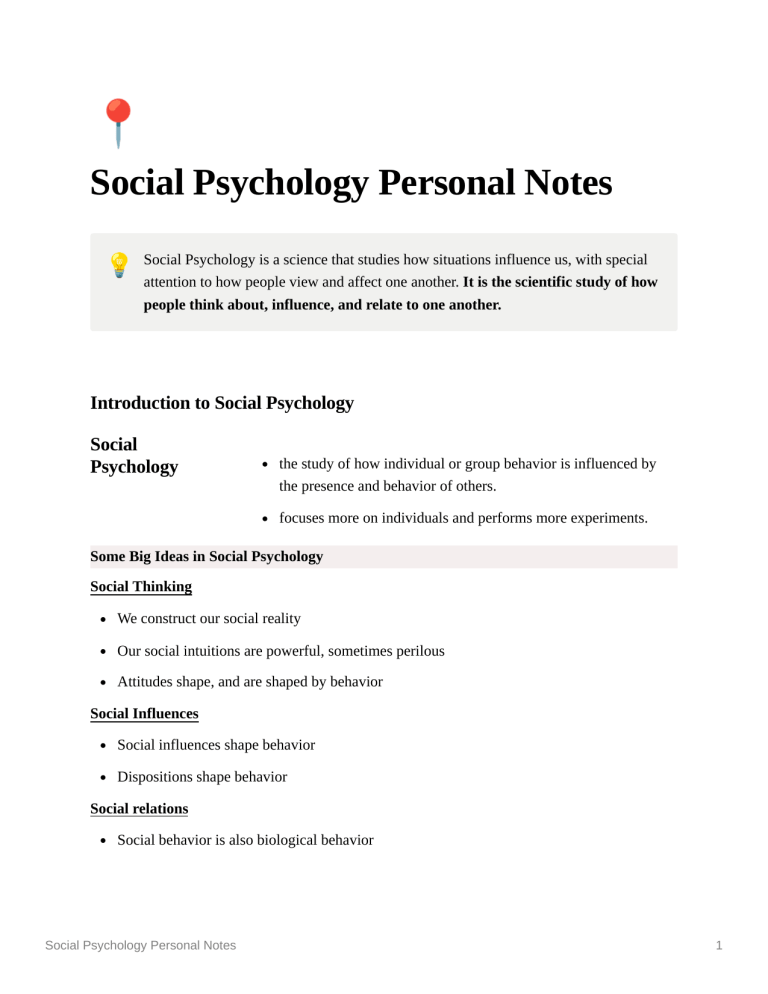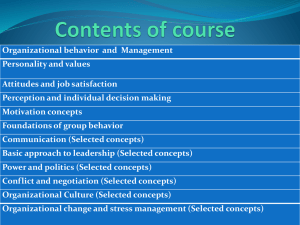
📍 Social Psychology Personal Notes 💡 Social Psychology is a science that studies how situations influence us, with special attention to how people view and affect one another. It is the scientific study of how people think about, influence, and relate to one another. Introduction to Social Psychology Social Psychology the study of how individual or group behavior is influenced by the presence and behavior of others. focuses more on individuals and performs more experiments. Some Big Ideas in Social Psychology Social Thinking We construct our social reality Our social intuitions are powerful, sometimes perilous Attitudes shape, and are shaped by behavior Social Influences Social influences shape behavior Dispositions shape behavior Social relations Social behavior is also biological behavior Social Psychology Personal Notes 1 Feelings and actions toward people are sometimes negative (prejudiced, aggressive) and sometimes positive (helpful, loving) Our Social Intuitions Are Often Powerful but Sometimes Perilous Our instant intuitions shape fears, impressions, and relationships. Intuition is huge, but intuition is also perilous. We intuitively judge the likelihood of events by how easily they come to mind. Social Influences Shape Our Behavior We are social animals, as described by Aristotle As social creatures we respond to our immediate contexts. Our standards regarding promptness, openness, and clothing very with our culture. “People are, above all, malleable” — Social psychologist, Hazel Markus We adapt to our social context. Our attitudes and behavior are shaped by external social forces. Personal Attitudes and Dispositions Also Shape Behavior Our inner attitudes affect our outer behavior. Ex. Our political attitudes influence our voting behavior Personality dispositions also affect behavior. Facing the same situation, different people may react differently. Social Behavior is Biologically Rooted Evolutionary psychologist remind us, our inherited human nature predisposes us to behave in ways that helped our ancestors survive and reproduce. Social neuroscience an interdisciplinary field that explores the neural bases of social and emotional processes and behaviors, and how these processes and behaviors affect our brain and biology. To understand social behavior, we must consider both under-the-skin (biological) and between-skins (social) influences. Social Psychology Personal Notes 2 Mind and body are one grand system. Hormones affect how we feel and act We reflect the interplay of our biological, psychological, and social influences. Social Psychology’s Principles Are Applicable in Everyday Life Is Social Psychology Simply Common Sense? Social Psychology faces two contradictory criticisms: First- that it is trivial because it documents the obvious Second- that it is dangerous because its findings could be used to manipulate people. Hindsight bias (I-knew-it-all-along phenomenon) The tendency to exaggerate after learning an outcome, one’s ability to have foreseen how something turned out. Almost any conceivable result of a psychological experiment can seem like common sense — after you know the result. Research Methods: How Do We Do Social Psychology? 📌 Forming and Testing Hypotheses 📌 Theory - is an integrated set of principles that explain and predict observed events. Facts - are agreed-upon statements about what we observe Theories - are ideas that summarize and explain facts Hypotheses - a testable proposition that describes a relationship that may exist between events. Serve several puporses: First, they allow us to test a theory by suggesting how we might try to falsify it. Second, predictions give direction to research and sometimes send investigators looking for things they might have never considered. Third, the predictive feature of good theories can also make them practical. How to conclude a good theory: Social Psychology Personal Notes 3 effectively summarizes many observations makes clear predictions that we can use to confirm or modify the theory generate new research suggest practical applications 📌 Sampling and Question Wording 📌 Sampling: Choosing Participants Random sampling - survey procedure in which every person in the population being studied has an equal chance of inclusion Sample size - the number of participants in a study 📌 SUMMARY: The Self: Understanding ourselves in a social context Spotlights and Illusions Spotlight effect - The belief that others are paying more attention to our appearance and behavior than they really are. Illusion of transparency - The illusion that our concealed emotions leak out and can be easily ready by others Self-Concept: Who am I? Self-concept - what we know and believe about ourselves At the Center of Our Worlds: Our Sense of Self Self-schemas - the elements of your self-concept, the specific beliefs by which you define yourself; Beliefs about self that organize and guide the processing of selfrelevant information. Social Psychology Personal Notes 4 Social Comparisons - evaluating one’s opinions and abilities by comparing oneself with others Other People’s Judgements - what matters for our self-concept is not how others actually see us but the way we imagine they see us. Self and Culture Individualism - the concept of giving priority to one’s own goals over group goals and defining one’s identity in terms of personal attributes rather than group identificationIndependent self - construing one’s identity as an autonomous self Collectivism - giving priority to the goals of one’s group and defining one’s identity accordingly. 📌 SUMMARY: Behavior and Attitudes Recall Notes Attitude defined as beliefs and feelings related to a person or an event What is attitude? feelings, often influenced by our beliefs, that predispose us to respond favorably or unfavorably to objects, people, and events Uses reaction times to measure how quickly people associate Implicit Association concepts Test (IAT) The 18 million completed tests since 1998 have, they report, shown that Social Psychology Personal Notes 5 implicit biases are pervasive. people differ in implicit bias. people are often unaware of their implicit biases. 📌 NOTE: Our expressions of attitudes and our behaviors are each subject to many influences. Our attitudes will predict our behavior if (1) if these “other influences” are minimized, (2) if the attitude corresponds very closely to the predicted behavior, and (3) if the attitude is potent When does our behavior affect our attitudes? ROLE PLAYING Role - a set of norms that defines how people in a given social position ought to behave When we act a role, we slightly change our former selves into being more like the role Saying Become Believing People often adapt what they say to please their listeners. When there is no compelling external explanation for one’s words, saying becomes believing. Evil and Moral Acts Evil sometimes results from gradually escalating commitments. Moral action, especially when chosen rather than coerced, affects moral thinking. Actions also affect our moral attitudes: That which we have done, even if it is evil, we tend to justify as right. Why does our behavior affect our attitudes? 1. Self-presentation theory - assumes that for strategic reasons, we express attitudes that make us appear consistent. Social Psychology Personal Notes 6 2. Cognitive dissonance theory - assumes that to reduce discomfort, we justify our actions to ourselves. 3. Self-perception theory - assumes that our actions are self-revealing: when uncertain about our feelings or beliefs, we look to our behavior, much as anyone else would. Self-Presentation: Impression Management To appear consistent to others, we may automatically pretend we hold attitudes that match our actions. Self-Justification: Cognitive Dissonance Cognitive Dissonance theory Our attitudes change because we are motivated to maintain consistency among our thoughts — implication of Leon Festinger Cognitive Dissonance Tension that arises when one is simultaneously aware of two inconsistent cognitions. Selective exposure another way to minimize dissonance this is the tendency to seek information and media that agree with one’s views and to avoid dissonant information Insufficient Justification Reduction of dissonance by internally justifying one’s behavior when external justification is “insufficient.” Attitudes follow behaviors for which we feel some responsibility Dissonance theory insists that encouragement and inducement should be enough to elicit the desired action Dissonance after Decisions Our preferences influence our decisions, which then sharpen our preferences. Self-Perception Assumes that we make similar inferences when we observe our own behavior. Expressions and Attitude Social Psychology Personal Notes 7 Facial feedback effect - the tendency of facial expressions to trigger corresponding feelings such as fear, anger, or happiness. Overjustification and Intrinsic Motivations Overjustification effect - the result of bribing people to do what they already like doing; they may then see their actions as externally controlled rather than intrinsically appealing. occurs when someone offers an unnecessary reward beforehand in an obvious effort to control behavior. Self-affirmation a theory that People often experience a self-image threat after engaging in an undesirable behavior they can compensate by affirming another aspect of the self Threaten people’s self-concept in one domain, and they will compensate either by refocusing or by doing good deeds in some other domain. Social Psychology Personal Notes 8



